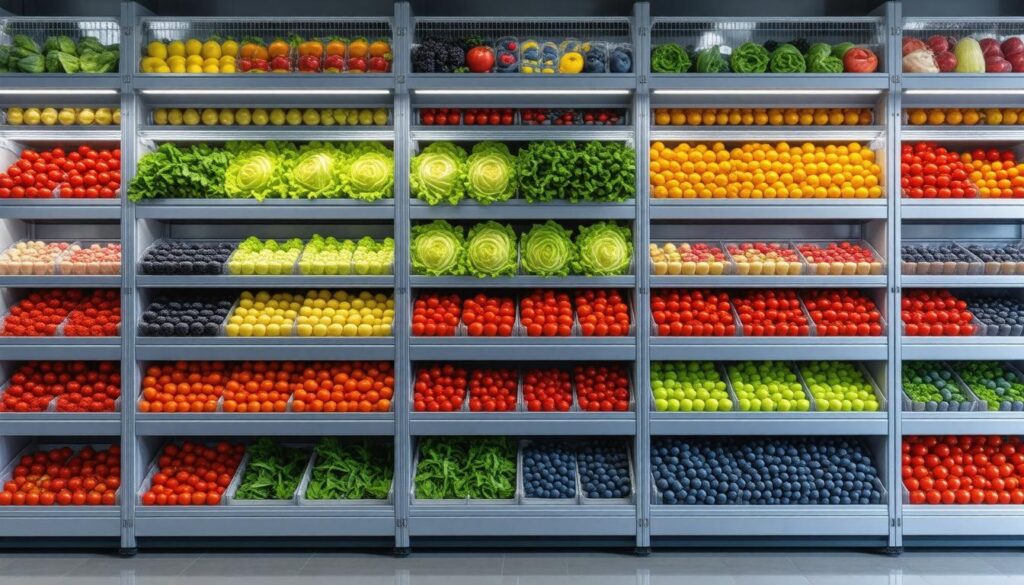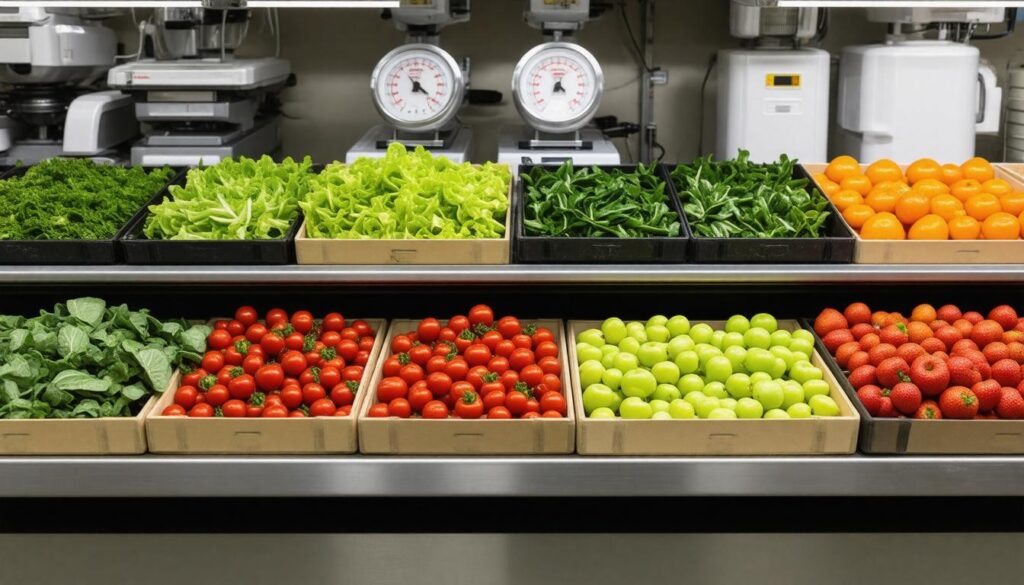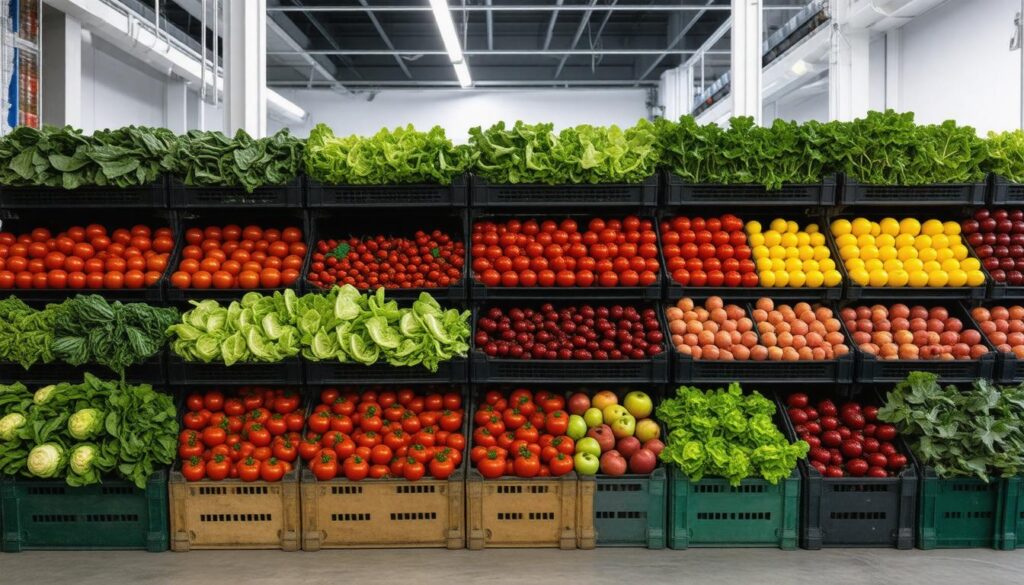When we bite into a fresh piece of fruit or crunch on a crispy vegetable, we often take for granted the journey it made to get there. From farms to grocery stores and finally to our tables, produce goes through a complex cold chain that is vital for maintaining its quality and flavor. But how do we keep those vibrant colors and delightful textures intact? The answer lies in understanding best practices for handling produce throughout this journey. In this article, we will explore essential techniques that help preserve freshness, reduce waste, and ensure that what you eat is both delicious and safe. So, let’s dive into the world of cold chain management and discover how each step plays a crucial role in delivering produce at its best.
The best practices for handling produce in the cold chain include continuous temperature monitoring to keep produce within optimal ranges, rapid cooling immediately after harvest to slow decay, and effective humidity regulation during storage to prevent spoilage. Additionally, gentle handling procedures throughout packing and transportation are essential to minimize damage and ensure the freshness of the produce.

Temperature and Humidity Management
Keeping a consistent temperature and humidity level is critical in the cold chain. Most produce thrives within specific temperature ranges, generally between 32°F (0°C) and 41°F (5°C). Straying from these values can trigger spoilage or compromise texture—too warm, and you hasten decay; too cold, and you risk freezing tender items like leafy greens.
For example, leafy greens flourish in high humidity—around 90% to 95%—to prevent wilting. If you’ve ever seen fresh spinach droop after it’s left out for too long, you’ll understand just how critical this is. On the other hand, apples prefer a slightly lower humidity level of about 90%, which helps them maintain their crispness without becoming mushy. Understanding the intricate needs of each type of produce can make all the difference in ensuring its optimal condition.
| Produce Type | Temperature Range (°F) | Humidity (%) |
|---|---|---|
| Leafy Greens | 32 – 34 | 50-70 |
| Apples | 32 – 34 | 90-95 |
| Berries | 32 – 36 | 90-95 |
| Tomatoes | 50 – 55 | 65-75 |
In practical terms, this boils down to carefully monitoring both temperature and humidity levels throughout storage and transit. The use of advanced technologies like smart sensors or IoT devices can play a pivotal role in this process. These tools provide real-time insights into the environmental conditions surrounding the produce, enabling quick adjustments to mitigate any risks.
Moreover, not all produce reacts the same way under these conditions. Certain berries should be stored at slightly warmer temperatures of around 32°F to 36°F while also keeping humidity levels around the mid-80s. Failing to respect these nuanced requirements might lead to serious quality loss or waste.
By committing to consistent monitoring and adjusting your practices based on the unique requirements of various produce types, you’ll significantly enhance freshness—not just for aesthetics but also for nutritional value. This meticulous approach directly contributes to smoother operations from farms through distribution networks and into your home kitchens, setting the stage for further exploration of essential equipment that supports these practices.
Best Equipment for Temperature Control
In the world of produce handling, the right equipment acts as your first line of defense against spoilage. One of the most critical tools to have at your disposal is refrigerated trucks. These specialized vehicles are not merely boxes on wheels; they are marvels of engineering designed to ensure that your goods remain fresh from point A to point B.
Refrigerated Trucks
Look for refrigerated trucks equipped with advanced compressors and humidity controls. These systems maintain ideal conditions, keeping temperature and humidity levels consistent throughout transportation. Their ability to adapt quickly is remarkable; if it gets too warm or too humid, the system kicks in immediately to correct it. Many modern refrigerated trucks feature user-friendly interfaces that allow drivers to monitor conditions while on the road, ensuring peace of mind during transit.
Smart Sensors
Smart sensors are game-changers in temperature control. They leverage Internet of Things (IoT) technology to provide real-time data on temperature and humidity levels, allowing immediate corrective actions if deviations occur. For instance, systems like the Tive Solo 5G offer features such as real-time alerts and tracking capabilities, notifying you instantly if something goes awry during transport or storage. Although these sophisticated devices require an initial investment, the long-term savings from reduced spoilage rates make them a wise choice.
Imagine receiving notifications on your smartphone about changes in temperature when you’re miles away from your cargo. This level of oversight can help prevent losses before they happen, ensuring freshness is retained and waste minimized. A tech-savvy approach enhances quality assurance and builds consumer trust, demonstrating commitment to handling produce with care.
Investing in both refrigerated vehicles and smart sensors reveals a broader picture: reliable equipment facilitates seamless integration across various stages of the cold chain, ultimately managing produce freshness effectively.
By adopting a multi-faceted approach that includes advanced equipment like refrigerated trucks alongside smart sensor technology, businesses can tackle temperature and humidity management within the cold chain. These tools work together smoothly to keep produce fresh and minimize financial losses.
Efficient Packing Methods

When it comes to packing produce for the cold chain, every detail matters. The goal is to pack fruits and vegetables in a way that preserves their freshness while minimizing damage during transit. Imagine you’re carefully placing ripe avocados into boxes—if you pack them too tightly or allow them to bounce around, you’ll find bruises and blemishes upon arrival. Understanding efficient packing methods can make all the difference in ensuring your produce arrives in perfect condition.
Proper Use of Insulated Containers
One of the first considerations should be the use of insulated containers. These containers maintain temperature stability, allowing for an even cooling effect during transport. It’s akin to wrapping your favorite dish in blankets; you want to keep it warm until you serve it. For the cold chain, insulated containers provide a safe environment for keeping produce at ideal temperatures between 32°F (0°C) and 41°F (5°C). Opting for containers with thermal mass capabilities allows the produce packaging to hold onto that cold longer without adding excessive weight.
But how you pack individual items matters just as much as what container you choose.
Breathable Packaging Materials
Using breathable materials is another key method for preserving the quality of packed produce. Fruits and vegetables require air circulation; otherwise, moisture can build up, leading to spoilage. For instance, perforated plastic bags can help maintain humidity while preventing excess condensation. By allowing air to circulate around delicate items like berries and leafy greens, you’re reducing the risk of mold and decay during transport.
Research has shown that inadequate airflow significantly shortens shelf life. Therefore, consider different types of packaging that enable effective ventilation while still offering protection.
Packing Density Matters
Next comes packing density—this refers to how tightly you fill your shipping containers. A good rule of thumb is to aim for a packing density of about 70–80%. Too loose and items might shift and bruise; too tight and they’re prone to compression damage. Think of packing like playing Tetris; you want a snug fit that supports each piece while leaving enough room for movement without risking damage.
Another aspect related directly to packing density involves utilizing gel packs or dry ice strategically within these containers. Placing them at the edges where they can cool down rather than suffocate the produce creates a protective barrier against temperature fluctuations during transit.
Importance of Clear Labeling
It may seem minor, but clear labeling communicates handling instructions and temperature requirements that are vital for maintaining compliance during transportation. You wouldn’t send someone off without explaining how long their journey would take or what route they should take! Similarly, labels guide everyone involved in logistics on how to treat packages—whether they need extra care or gentle handling.
Smartly utilizing insulated containers, breathable materials, proper packing density, strategic cooling solutions, and clear labeling ensures your produce remains fresh from farm to consumer. These practices will undoubtedly assist in minimizing waste while maximizing quality in cold chain logistics.
Safe Loading and Unloading Practices
The delicate dance of loading and unloading produce can make all the difference between a fresh delivery and a spoiled batch. One essential aspect is Pre-Cooling. Before any loading takes place, ensure that both trucks and storage units are pre-cooled to the desired temperature. This preparation minimizes the risk of sudden temperature spikes that could jeopardize the quality of your goods. Imagine standing in front of a hot oven without air conditioning—now, think about how that would feel for freshly harvested tomatoes! They need their optimal chill to stay at their best.
Next comes Efficient Transfer, where speed plays an important role. Aim to load and unload quickly, as prolonged exposure to ambient temperatures can lead to unwanted deterioration. Nevertheless, while haste is important, it should never come at the cost of gentle handling. Produce is often sensitive; even a slight bruise can start the decay process, so encouraging employees to use caution is paramount. Utilizing pallet jacks effectively can speed up this transfer while ensuring safety and care. Always check that dock doors seal tightly too—trust me, if cold air escapes, you’ll be left battling the heat with every passing second.
Furthermore, establishing strict protocols not only helps in maintaining optimal conditions but also cultivates a culture of responsibility and efficiency among team members.
Regular checks on loading equipment like forklifts and pallet jacks are vital to ensure they’re functioning properly; malfunctioning equipment can drastically increase handling time and inadvertently harm the product itself. Additionally, managing handling times is key; limit the time produce spends outside of cold storage to no more than 30 minutes. This simple but powerful rule helps shield your merchandise from temperature abuse.
As a little extra advice:
- Incorporate training sessions that educate staff on safe handling techniques.
- Encourage open communication regarding equipment checks and any potential concerns during logistics.
- Develop a vigilant system for monitoring temperature readings during the loading phase.
Incorporating these strategies will significantly enhance your operations and ensure your produce arrives at peak freshness. This seamless approach leads us directly into exploring essential methods for maintaining ideal environmental conditions during storage.
Optimal Cold Storage Techniques
Once your produce enters cold storage, maintaining its condition becomes critical. A well-designed storage system must be climate-controlled, ensuring each type of produce remains at its specific optimal temperature. This is not just about keeping things cold; it’s about precision. Each fruit and vegetable has a temperature range in which it thrives, and utilizing adjustable storage racks can help accommodate this diversity effectively.
Keeping strawberries at 32°F (0°C), for example, helps maintain their juiciness, while leafy greens prefer slightly higher temperatures closer to 36°F (2°C).
Emphasizing proper temperature control ensures that everything lasts longer and tastes better.
FIFO Method
One of the most effective strategies for inventory management in cold storage is the First In, First Out (FIFO) method. By adhering to FIFO practices, you ensure that the oldest stock is used before newer stock, thus minimizing waste and preserving freshness. This process is particularly crucial in the fast-paced world of fresh produce where shelf life can be limited.
Adopting FIFO not only helps reduce spoilage but also promotes consistency in your supply chain. Regular checks should be made to rotate stock and confirm that older items are prioritized for dispatch or use.
Effective inventory management goes beyond just rotation; it extends into careful monitoring of conditions within the storage facility.
To optimize your cold storage space further, strategic organization plays a role; grouping similar items together can reduce accidental exposure to different microenvironments that could potentially damage sensitive produce. For instance, placing ethylene-producing fruits like apples away from other fruits can prevent premature ripening and spoilage. Additionally, consider implementing smart storage solutions such as real-time temperature and humidity sensing technology. This can alert you to fluctuations that could compromise the quality of your products.
Maintaining these practices consistently will lead to enhanced quality assurance, but it’s equally important to anticipate challenges.
Another key aspect of optimal cold storage involves planning for potential disruptions in the cold chain. Back-up power supplies and regular maintenance checks on cooling systems are essential defenses against unexpected failures. Keeping a detailed log of equipment functioning along with routine inspections creates a proactive approach to safeguarding product freshness.
Extending Shelf Life of Produce

Various techniques can significantly lengthen the lifespan of fresh produce, preventing waste and ensuring quality. One notable method is Modified Atmosphere Packaging (MAP). This innovative approach alters the composition of gases surrounding the produce, typically by decreasing the oxygen levels and increasing the levels of carbon dioxide or nitrogen. By doing this, respiration rates slow down dramatically. When properly executed, MAP can keep fruits and vegetables fresher longer than traditional packaging methods. The result? Ingredients that still look vibrant and taste fantastic days after purchase.
When combined with other preservation methods, MAP becomes even more effective in maintaining freshness.
Controlled Atmosphere Storage
Another advantageous technique is Controlled Atmosphere Storage (CAS). This method is particularly effective for commodities like apples, which are stored in sealed environments where oxygen and carbon dioxide levels are carefully adjusted and monitored. The key here is balance; maintaining precise gas levels can delay ripening and spoilage significantly—sometimes for months instead of weeks. These systems require ongoing supervision and fine-tuning. Thus, investing in automated monitoring systems can be incredibly beneficial for maximizing efficiency.
Using CAS not only preserves freshness but also minimizes the risk of spoilage, thus contributing to food waste reduction efforts.
Additionally, researchers are examining a range of hormones beyond melatonin that could have substantial effects on the longevity of various crops. Modifying or enhancing the hormonal environment around certain perishables can bolster their resilience against stress during transportation and storage.
Understanding these cutting-edge techniques today helps in preserving quality and reducing waste while enhancing the overall consumer experience.
Ensuring Cold Chain Safety
When it comes to safeguarding produce during transport, a proactive approach is vital. Every layer of the process contributes to maintaining the quality and safety of your products. From staff training to high-tech monitoring systems, each aspect serves as a protective mechanism against potential pitfalls in cold chain operations.
Compliance and Training
Regular training for staff members on cold chain best practices is essential. This isn’t just a box-ticking exercise; it’s foundational. Equipping your team with knowledge about compliance regulations like the Food Safety Modernization Act (FSMA) empowers them to recognize the importance of their roles in maintaining safety standards.
Perhaps you’ve experienced how a confident worker can handle unexpected situations—whether it’s adjusting temperature controls or managing product exposure during loading—because they’ve been trained properly.
Ongoing education builds a culture of safety that transcends mere compliance; it fosters pride in one’s work and commitment to quality.
Continuous Monitoring
Integrating environmental sensors into your cold chain logistics can revolutionize how you manage conditions. These sensors continuously monitor and log temperature and humidity levels in real-time, offering peace of mind that you’re always within safe operating parameters. Imagine receiving immediate alerts if temperatures fluctuate outside of set limits! This capability not only aids in maintaining compliance but also allows for swift corrective actions, which significantly reduces the risk of spoilage.
Routine audits and checks within this framework preemptively catch potential pitfalls before they escalate into issues that could jeopardize product integrity. If a sensor alerts you to an issue with refrigeration equipment, you’ll have ample time to resolve it without loss.
Investing in these technologies and subsequent training isn’t just about mitigating losses; it’s about fostering long-term gains through improved efficiency and customer satisfaction. Every byte of data recorded by these advanced tools helps track compliance and can be used in predictive analytics for future operations.
In essence, ensuring cold chain safety is a multifaceted effort that hinges upon employee competence and technological integration—both critical elements that pave the way for reliable logistics solutions benefiting everyone involved.
Implementing these best practices not only safeguards produce but also bolsters overall operational success, leading to enhanced product quality and customer trust. Embracing a comprehensive approach towards cold chain management lays down the foundation for lasting excellence.

